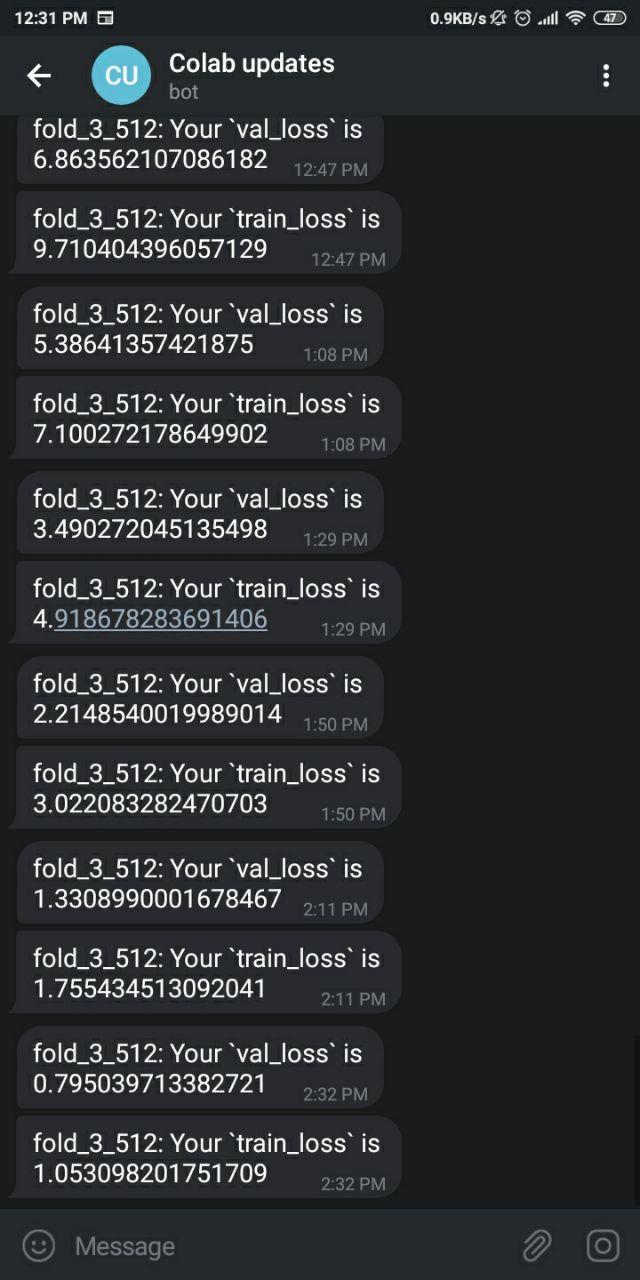Telegram Bot
import requests
def send_message(msg, chat_id, bot_token):
"""
params:
-------
msg: message you want to receive
chat_id: CHAT_ID
bot_token: API_KEY of your bot
"""
url = f'https://api.telegram.org/bot{bot_token}/sendMessage'
data = {'chat_id': str(chat_id), 'text': f'{msg}'}
requests.post(url, data)
This is all the code you need. I know its not a lot of code but same is the case with many useful things. Useful things are simple by design. Instead of using print() you can use send_message() from above. I called it after each epoch to get the “val_loss” and “train_loss” while training models on colab. Heres how it looks:

Generally speaking, you can also use it to notify you ABOUT ANYTHING.
Finding chat_id and bot_token . . .
As you might have already realized that the above code won’t work without “CHAT_ID” and “BOT_TOKEN”. So, how do you find them?
First, we will have to create a bot. You need to use “TheBotfather” in the Telegram app. You can find it here or by searching for “botfather” in the Telegram app.
In the chat with The Botfather, enter “/newbot”. It will ask you for a name, then a username for your bot. Once you provide both, The Botfather will provide you with a link to your bot and an API token.

Your {API_KEY} is your “BOT_TOKEN”. Now, follow the link to your bot by clicking the link that looks like t.me/{yourBotUsername}. This is where you will receive messages.
Second, we need to send it a message to enable the bot to message us back. So, go ahead and send a message to your bot. We will read this message via the Telegram API to get the “CHAT_ID”.
Visit https://api.telegram.org/bot{API_KEY}/getUpdates via browser or curl (unix command) after sending the message.
It should then return a JSON object that looks something like this:
{"ok":true,"result":[{
"update_id":36317827,
"message":{"message_id":407,
"from":{"id":{CHAT_ID},
"is_bot":false,
"first_name":"Ankur",
"last_name":"Singh",
"language_code":"en"},
"chat":{"id":{CHAT_ID},
"first_name":"Ankur",
"last_name":"Singh",
"type":"private"},
"date":1597155237,
"text":"Hi bot"
}
}]
}
You would get a empty result if you forget to send message earlier.
{"ok":true,"result":[]}
Take the {CHAT_ID} value, its a 9 digit number.
Now, you have your “BOT_TOKEN” (i.e. API_KEY) and “CHAT_ID”.
Word of caution
Never hard-code or share your “BOT_TOKEN” and “CHAT_ID”. You can either set them a environment variables or pass them from the command line (as arguments).
Final words
Finding your “BOT_TOKEN” and “CHAT_ID” is a one time thing. Once you have your “BOT_TOKEN” and “CHAT_ID”, you can set them as environment variables. Then you can use partial() method from functools library to set your “BOT_TOKEN” and “CHAT_ID”.
import os
from functools import partial
#original send_message
def send_message(msg, chat_id, bot_token):
...
send_message = partial(send_message,
chat_id=os.environ['CHAT_ID'],
bot_token=os.environ['BOT_TOKEN'])
# to sends message to your bot.
send_message('hello to you bot!')
Now, using send_message() is as simple as calling print().
If you found it useful and happen to use it, then let everyone know by sharing your use-cases in the comment section below. Looking forward to hear from you.